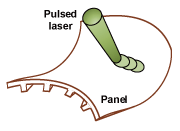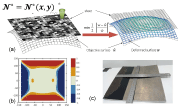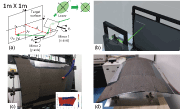Introduction
Laser peening is a well-known process for mechanical surface treatment of high-value components, especially for applications in aerospace and nuclear industries to improve fatigue and corrosion resistance. Because the high dynamic pressure loading induces plastic deformation on the surface layer, deflections are usually produced for components with low stiffness to resist the bending. Although deflection control is still a challenging problem in laser peening, the unexpected bending can be used for complex shaping and correction of metal plates, which brought the invention of laser peen forming in the 2000s.
Laser peen forming has proved to be a promising high-flexible forming process to produce complex shapes. Compared with shot peen forming with the plastic layer less than 0.2 mm, laser peen forming has higher shaping capability because it generates a deformed plastic layer with the thickness up to 1.0 mm. Moreover, shot peen forming is a stochastic process with a large number of shots ejecting onto the panel surface, while laser peen forming is much easier to control through a deterministic process over each laser pulse. Therefore, laser peen forming will have a broad application prospect in the industry in the future.
Motivation
Large-scale panels are critical components in the aerospace industry to gain high structural efficiency and advanced aerodynamic performance. Compared with the assembly structures, the panel with stiffening ribs can reduce weight of 10-30%, assembly cost of 80-90%, and improve the fatigue resistance of 25-30%. Because of large panel size and low-volume production, panel forming is a widely concerning problem in the industry.
As a flexible forming process without tool and die, laser peen forming is an available effective process for the complex shaping of the large-scale panel with small curvatures, as shown in Fig. 1. Concerning the main characteristics of large-scale size, complex shape, and low stiffness, one challenge to utilize laser peen forming for complex shaping of panels is to achieve quantitative shape control under a large amount of laser shock irradiations. The shape control requires developing an efficient model for shape prediction and inverse process optimization. Furthermore, the commonly adopted fixed-beam facility by integrating laser and an industrial robot is inapplicable because of its low efficiency requiring frequent movement of panels along with laser pulses. Therefore, designing a facility for large-scale panel forming is of great necessity.
Research progress
Comprehensive investigations have been devoted to laser peen forming towards improving understanding of bending behaviors in laser peen forming. Previous investigations have experimentally clarified the upward and downward bendings, proposed an efficient model for process planning, and developed a scanning beam facility to demo several cases of large-scale panel applications.
Experiments were conducted to understand bending behaviors of metal sheet and fiber metal laminates with a thin section [1, 2]. As shown in Fig. 2,a the experiments on the thin aluminum sheet observed two-way bending directions toward and away from the incident laser beam. Moreover, the bending deformation is found to be varied continuously and smoothly from the concave form to the convex by increasing the sheet thickness or decreasing the laser intensity. The downward bending is commonly used to deform large-scale panels with small curvatures, ensuring compressive residual stresses on both sides after laser peen forming. To improve the capability of downward bending, mainly required by panels with high stiffening ribs, prestress is an effective way to increase the curvature radius by introducing more in-plane plastic strains on the surface layer plate [3]. As shown in Fig. 2b, after utilizing prestressing laser peen forming, plates with thicknesses of 18 mm and 23mm can be deformed with curvature radii of 2.7 m and 3.9 m respectively. Besides, laser-assisted laser peen forming (LALPF) is proposed as a hybrid process to combine laser heating and laser peen forming to improve the bending capability. It has been also demonstrated to be useful for bending titanium sheet, the strength of which is thermal-sensitive [4].
Modeling of laser peen forming plays an essential role in panel application because the large-scale surface requires a considerable amount of laser shocks, and complex shaping with the tool-free process makes experience-based trial and error incompetent. Direct modeling of the laser peen forming process by the finite element method is to simulate the dynamic response of target material under high transient pressure resulting from laser irradiation. But it is difficult to predict for a large-scale component considering the geometry effect, which requires a full-size model. Defining an equivalent intermediate quantity can be useful in calculating shock effects with high efficiency, avoiding spot-by-spot simulation. An effective intermediate quantity must include all effects from main process parameters. Eigenstrain is proposed as an effective intermediate quantity for the process under small deformation in laser peen forming [5]. It can be decomposed into elongation and bending components. By defining the eigen-moment to relate bending deflection with a Partial Differential Equation (PDF), process optimization for complex shaping is defined as an optimization problem of the distributed eigen-moment with PDF constrain [6]. The eigen-moment is verified to be an intrinsic physical quantity to describe the bending behavior of laser peen forming, and its distribution can be optimized by adopting the interior-point algorithm to obtain the desired shape. A complex shape with saddle geometry, as shown in Fig. 3, is used as a typical case to demonstrate the method. PDE based optimization of the eigen-moment field converges to obtain an expected saddle shape as validated by experiments on aluminum alloy 2024-T351[5].
In order to demonstrate the capability of laser peen forming to form large-scale panels with the desired shape, a prototype of a three-dimensional scanning facility is developed for experiments. As shown in Figs. 4a & b, a galvanometer is integrated into the facility to deliver laser pulses to the target surface. The optical lens corrects the distorted spot shape because of oblique incidence. With the assistance of the optimization algorithm, forming has been achieved as shown in Figs. 4c & d.
Summary
As demonstrated by the previous work, laser peen forming has been proposed as a flexible tool-free process with high shaping capability. PDE-based optimization of distributed eigen-moment provides an effective method for complex geometry shaping. To allow more accessible processes in manufacturing industries, there is still much research to be done on the application of laser peen forming to aerospace panels, such as the shock sequence effect on the bending, rapid shape on-site measurement and process-based panel development, which requires a multidisciplinary group to make an intensive contribution.
Acknowledgments
Funding for the research has been provided by NSFC, STCSM; and from COMAC, CASC in Shanghai.
References
[1] Y. Hu, X. Xu, z. Yao, J. Hu, Laser peen forming induced two way bending of thin sheet metals and its mechanisms, Journal of Applied Physics, 108 (2010) 073117.
[2] Y. Hu, X. Zheng, D. Wang, Z. Zhang, Y. Xie, Z. Yao, Application of laser peen forming to bend fibre metal laminates by high dynamic loading, Journal of Materials Processing Technology, 226 (2015) 32-39.
[3] Y. Hu, Z. Li, X. Yu, Z. Yao, Effect of elastic prestress on the laser peen forming of aluminum alloy 2024-T351: Experiments and eigenstrain-based modeling, Journal of Materials Processing Technology, 221 (2015) 214-224.
[4] M. Luo, Y. Hu, D. Qian, Z. Yao, Numerical modeling and mechanism analysis of hybrid heating and shock process for laser-assisted laser peen forming, Journal of Manufacturing Science and Engineering, Transaction of ASME, 140 (2018) 111009.
[5] Y. Hu, R.V. Grandhi, Efficient numerical prediction of residual stress and deformation for large-scale laser shock processing using the eigenstrain methodology, Surface & Coatings Technology, 206 (2012) 3374-3385.
[6] M. Luo, Y. Hu, L. Hu, Z. Yao, Efficient process planning of laser peen forming for complex shaping with distributed eigen-moment, Journal of Materials Processing Technology, 279 (2020) 116588.
For information:
School of Mechanical Engineering
Shanghai Jiao Tong University
708 Mechanical Building A
No.800 Dongchuan Road,
Shanghai 200240, China
E-mail: huyx@sjtu.edu.cn































